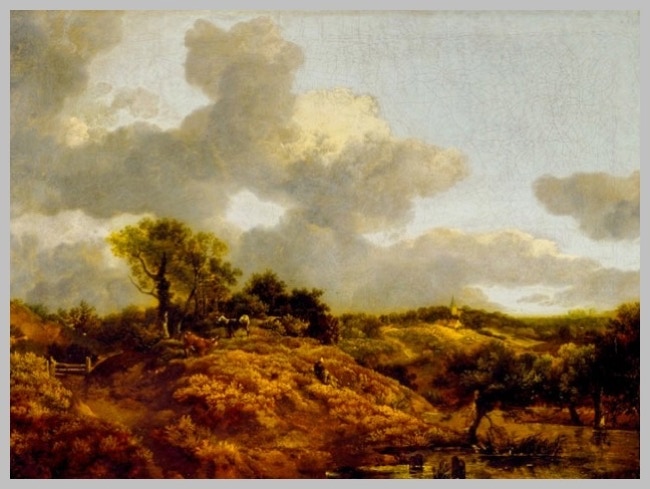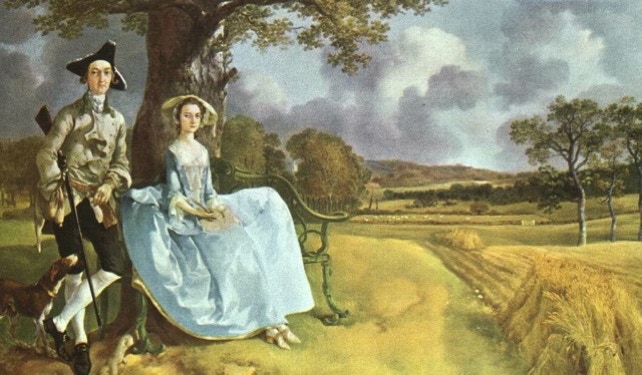

A Technological Threat to the Landscape:
Thomas Gainsborough's Response.
More revelations from historian Barry Wall
In our original Gainsborough article we told you about some amazing new revelations concerning one of Thomas Gainsborough's paintings and how local historian Barry Wall is bringing our local history to life. In this new article we want to bring you a further chapter in this story, a chapter that once again shows the relevance of Thomas Gainsborough's paintings for those of us who campaign to preserve the natural beauty of our landscape.
Along with literally hundreds of other people, Stour Valley Underground representatives contribute to the consultation through the Community Forums that National Grid are conducting as part of their planning process. This they hope will eventually permit them to despoil our landscape with more pylons. Within that process National Grid have environmental consultants collecting information on the land through which they want to run more pylons. We fear that they will fail to properly capture the importance of our landscape because so much of its value is only really known of by those of us who live here. There is much that is neither known or recorded by the authorities or establishment organisations, including the national ones who set out to campaign against the despoilment of our built and natural heritage.
So here we have an example of the importance of local knowledge and the need for it to feed into this process and be weighted in terms of importance at least as highly as the data that an environmental scientist's desktop survey captures from official sources.
This article sets out to answer just one question:-
Why did Thomas Gainsborough paint Wooded Landscape with Herdsman Seated?
The simple answer is that 264 years ago, Thomas Gainsborough saw a landscape that he believed was threatened by technology and responded to the threat by creating a work of art. The evidence to support this remarkable claim is to be found in his paintings, as you will see.



Thomas Gainsborough's Wooded Landscape with Herdsman Seated:






why was it paintedandwhat links him and us?
Stour Valley Underground immediately recognised the importance of highly respected local historian Barry Wall's discovery of the Gainsborough view that we have been publicising. He identified the fact that the view depicted in a 1748 oil painting by Gainsborough still exists, just over the border from Gainsborough's Sudbury Suffolk home, into Essex. The painting is on public display as ithangs in the Gainsborough's House Museum in Sudbury. Barry Wall's discovery and research surrounding Gainsborough's work is clearly important, as can be judged from the extensive national newspaper coverage of the discovery by the press. Thus far it has been reported in the Sunday Times, The Telegraph and The Mirror along with the East Anglian Daily times and other local newspapers. Our online article covering this is available here.
But Barry's latest work and research amongst the archives at Gainsborough's House has produced an astonishing revelation:Thomas Gainsborough painted Wooded Landscape with Herdsman Seatedin response to his realising the threat that mid 18th century technology posed for the natural beauty of the landscape. And that is why he painted his picture. He did it to preserve that natural beauty in the only way he could, by recording it for posterity in a painting before it was changed for ever.
So the next question is: what was the threat that Gainsborough saw?
Gainsborough painted both as his day job and for the love of it: commissioned, fee earning portraits for others, landscapes for himself. Just before the time he painted Wooded Landscape, he was commissioned to paint the famous portrait "Mr & Mrs Andrews", reproduced here.
This painting includes features that Gainsborough was told to include. It is after all, a statement about Mr & Mrs Andrews, their status and values. The Andrews' are depicted in the latest fashions and he with the most up to date form of weapon under his arm. But there is a more subtle representation of Mr Andrews' embracing of all that was modern to be seen here. Half of the picture is given over to a depiction of an agricultural view. To the right of the picture there is corn growing, not as a result of broadcasting of seed by hand but in a fashion that is the result of the then latest seed drill technology. The rationale for this part of the painting shows that Gainsborough was well aware that ploughing and seed drilling would change the natural appearance of the countryside.
Stour Valley Underground have always maintained that it is the whole of the "painters landscapes" that need preserving from the ravages of National Grid's technologies. And this is a story that shows how Gainsborough paintings from across the area are linked and bring a cultural heritage importance to the entire area. We can demonstrate this with a little more history gleaned by Barry Wall from resources at the Gainsborough's House Museum.
In 1741, a certain John Piper bought the Ballingdon Hall Estate and farms which at the time included the Ryes Hall farm. This is the farm which is host to the Gainsborough's "Wooded Landscape" viewpoint. Piper bought the estate in part to include All Saints Church (Sudbury) as he wanted a role in the church. He had to wait until the sitting Vicar had passed on to achieve this and move into the Rectory but this meant that John Piper lived down the road from Thomas Gainsborough. Records suggest that they knew each other and were seemingly friends. Gainsborough even incorporated images of his friend's church and some other of his buildings including barns into various of his masterpieces. From this we know that Gainsborough had a detailed knowledge of Piper's lands.
The Andrews estate sat on the north Essex border beside the Ballingdon one (either side of what is now the A131) and it seems that Gainsborough saw the march of (agricultural) technology and the way it impacted the natural beauty of the area through thecombined effect of ploughing and the use of seed drillswhilst working on the Andrews painting. His response was to paint "Wooded Landscape" before the natural scene on Piper's estate near Henny was lost to the impact of technology for ever.
264 years later, we cannot afford to preserve the landscape's memory through a painting because it now has such enormous cultural heritage value. So we have to preserve the landscape itself in perpetuity. The landscape as we can see it today in Henny exhibits the impacts Gainsborough foresaw and yet is today a scene of great natural beauty, encompassing all of the major features of Gainsborough's painting.









Going forward SVU will be working to show that it is in fact the whole of thePainter's Landscapes, Constable's and Gainsborough's that we have to value, preserve and hopefully protect with an extended Area of Outstanding Natural Beauty (AONB). To this end our next efforts will go toward demonstrating the importance of views and settings such as Gainsborough's "Riverside View with Distant Village" which hangs in the National Gallery of Scotland, Edinburgh.









This is in fact a view from beside the Bures Road from Sudbury, at an easily identified location as this vantage point can be found by watching for where the river comes closest to the road. The church in the distance is St Mary's at Bures.
We are again deeply indebted to Barry Wall for bringing this story to us in the hope that it will help us. His work may yet turn out to be of the greatest importance to our succeeding in our endeavours.
Given the above, it would seem that thefolk of the Suffolk - Essex bordershave been responding to technological threats to the natural beauty of their landscape for 264, not just 2 years!



